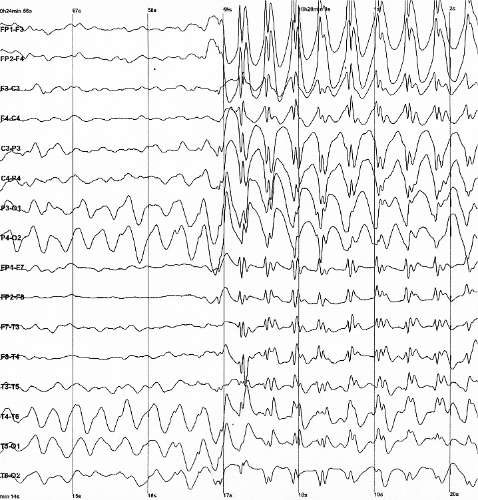Epileptic Encephalopathy, Early Infantile, 43

A number sign (#) is used with this entry because of evidence that early infantile epileptic encephalopathy-43 (EIEE43) is caused by heterozygous mutation in the GABRB3 gene (137192) on chromosome 15q11.
For a general phenotypic description and a discussion of genetic heterogeneity of EIEE, see EIEE1 (308350).
Clinical FeaturesThe Epi4K Consortium and Epilepsy Phenome/Genome Project (2013) reported 4 unrelated patients with infantile epileptic encephalopathy. The patients had onset of multiple seizure types within the first year of life, including absence, myoclonic, and generalized tonic-clonic seizures. Three patients with available clinical information showed global developmental delay; 2 of these had behavioral abnormalities. The Epi4K Consortium and Epilepsy Phenome/Genome Project (2013) concluded that their results implicated the GABRB3 gene in epileptic encephalopathy. The Epi4K Consortium (2016) reported follow-up of the patients reported by the Epi4K Consortium and Epilepsy Phenome/Genome Project (2013), who ranged from 11 to 20 years of age. One had mildly delayed development and the 3 others had mild to severe intellectual disability.
The Epi4K Consortium (2016) reported 7 additional patients with EIEE43. Six had onset of multiple seizures types within the first year of life. Only 2 of these patients had normal development prior to onset of seizures. All had mild to profound intellectual disability. The seventh patient, a 19-year-old girl with severe intellectual disability, had delayed development apparent at age 6 months, but did not develop seizures until age 12 years. One case had a family history of genetic epilepsy and febrile seizures plus (GEFS+). Combined with the 4 previously reported patients (11 patients total) 5 had severe to profound intellectual disability, 3 had mild to moderate disability, and the degree of cognitive impairment was unclear in the remaining 3. Predominant seizure types were myoclonic, tonic, absence, and generalized tonic-clonic seizures. EEG showed multiple variable abnormalities, including generalized spike-wave discharges, background slowing, and hypsarrhythmia.
Molecular GeneticsIn 4 unrelated patients with EIEE43, the Epi4K Consortium and Epilepsy Phenome/Genome Project (2013) identified different de novo heterozygous mutations in the GABRB3 gene. The patients were part of a larger cohort of 264 probands with epileptic encephalopathy who underwent exome sequencing. A statistical likelihood analysis indicated that the probability of this finding occurring by chance was p = 4.1 x 10(-10). Functional studies of the mutations were not performed. The Epi4K Consortium and Epilepsy Phenome/Genome Project (2013) concluded that their results implicated the GABRB3 gene in epileptic encephalopathy.
In 7 previously unreported patients with EIEE43, the Epi4K Consortium (2016) identified heterozygous mutations in the GABRB3 gene (see, e.g., 137192.0005-137192.0008). The mutations were found by targeted sequencing of 27 candidate genes in 531 patients with a similar disorder. Functional studies of the variants and studies of patient cells were not performed. Five of the mutations were confirmed de novo, 1 could not be confirmed de novo, and 1 segregated with a GEFS+ phenotype in a family (proband EG0258). GABRB3 mutations accounted for 1.3% of the cohort.